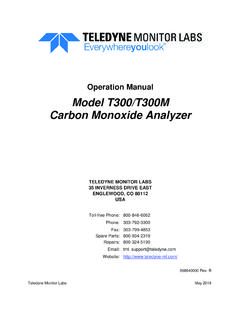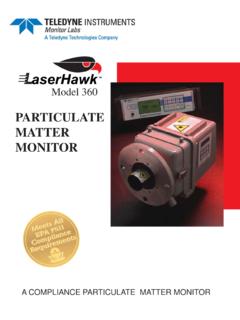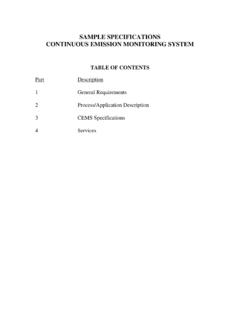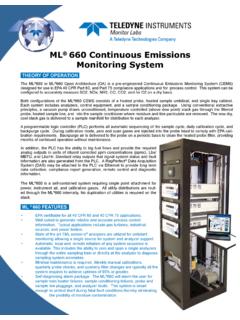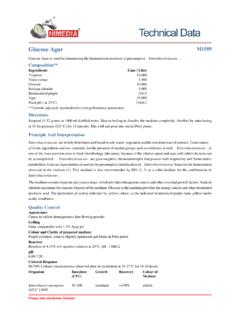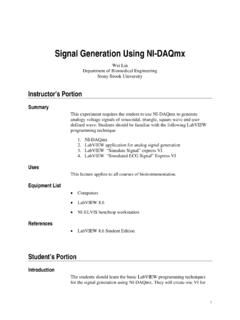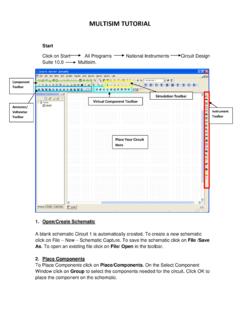Transcription of SM425 - Teledyne Monitor Labs Inc
1 S M 4 2 5 Zirconia Oxygen Analyzer INSTRUMENT OVERVIEWThe SM425 is ideally suited for both compliance monitoring of diluent gas (Environmental Compliance) and Oxy-gen monitoring for combustion and pro-cess control applications. The SM425 offers state of the art oxygen analysis and a rugged industrial and engineers will appre-ciate the in situ design of the oxygen analysis probe. It provides the rapid response required for combustion con-trol while eliminating the need for high maintenance sampling components. The flue gas flow around the zirco-nium oxide sensor is accomplished completely within the process and the sensor equilibrates with process condi tions. As the oxygen is measured un-der actual flue conditions, the measurement is a true wet gas in situ operation of the probe not only assures a rapid response to changing flue conditions, it also assures the integrity of the sample.
2 The no compromise design fosters operator acceptance of the ana-lytical results through the reliability of the data. The reliability of the design extends from the high quality digital components to the field-replaceable zirconium detec-tor cell. Using modern production tech-niques, the zirconium oxide cell shows excellent stability over long periods and repeatable performance from cell to cell. The stability and reproducible character-istics of the cell allow it to be replaced in the field without extensive recalibration and linearization electronics package for the SM425provides for control over the probe, output linearization, scaling, display, andother functions. The device is micro-processor-based and exhibits high ac-curacy as well as a high degree of re-liability. The operation procedures are straightforward and accessible through specific function keys and a large LED display.
3 Manual calibration data is ac-tivated through a one-touch calibration key. A fault detection function further assures the reliability of the measured values. In the unlikely event a fault should occur, it is immediately detected and an alarm activated, providing the operator with a visual indication of the fault as well as a contact closure for re-mote alarm activation. These features enhance the operator s acceptance and gain his complete confidence in the system. GENERAL DESCRIPTIONWHY MEASURE OXYGEN?Combustion air is input to a boiler s combustion system and controlled by a fan and damper system. The fuel and air are ratioed to produce safe, efficient, combustion under all condi-tions or variations in the fuel and air control parameters. However, they are only optimized at that point in time when the burner is tuned.
4 Ambient temperature, pressure, and humidity change from hour to hour and season to season. These changes, as well as control system variations, result in sig-nificant variations in the mass flow rate of oxygen input to the combustion pro-cess. This, in association with varying fuel demands, adversely affects actual fuel/air a given concentration of oxygen, which is consistent with that required for normal fuel/air ratios and efficient combustion, can be accom-plished by adjusting the fuel/air ratio in association with a continuous mea-surement of the flue gas oxygen con-tent. The normal sources of variations in air/fuel ratio are compensated for on both an automatic and continuous SAFETYIn the day-to-day operation of a boiler, malfunctions may occur which could result in dangerous substoichiometric conditions.
5 Under worst case condi-tions, the malfunction could result in a build up and explosion of fuel-rich gas-es. Conditions such as burner nozzle erosion, damper failure, intake block-age, and loss of a phase to a fan drive motor, would precipitate substoichio-metric conditions. Flue gas oxygen monitoring and alarm upon lowoxygen content can, however, help to prevent hazardous SAVINGSIn the operation of any burner system, there is a point where fuel utilization is maximized. The point of optimum efficiency lies somewhere between stoichiometric and high excess air operation. If the burner is operated in the stoichiometric region, or below, fuel is lost up the stack in the form of carbon monoxide and other partially oxidized hydrocarbons. If the burner is operated with too much excess air, the unnecessary excess air is raised to combustion temperatures and lost up the stack.
6 The use of an oxygen analyzer to Monitor the amount of oxygen in the flue, facilitates burner system operation with the correct amount of excess air, while avoiding substoichiometric the oxidation of carbon-nitrogen compounds in solid fuels. The emission of oxides of nitrogen can be minimized by operating burners with a minimum of excess and future, federal and state regulations on the emissions of oxides of nitrogen are causing industry to seek the most economical method to reduce this pollutant. Of the many different methods proposed or in use today, several variations of combustion modification are the primary methods which promise cost-effective reduction of NOx emissions. However, the method selected depends upon many variables including: fuel type, retrofit costs, effect on efficiency, and existing waste heat recovery systems presently in of the method selected to reduce oxides of nitrogen emissions, the method should result in compliance with present and future governmental controls.
7 Whether controlling excess air to increase combustion efficiency or to minimize the formation of oxides of nitrogen, analyzers such as the SM425 should be installed for effective monitoring of excess OXIDE CELLFlue gas oxygen content is sensed by a zirconium oxide, fuel cell type sensor. The sensor causes electrons to flow in a measuring circuit, proportional to the partial pressure differential of oxygen in the reference gas (air or instrument air) and the flue OF NOxOxides of nitrogen are formed during the combustion process. Formation is due to operation under high excess air conditions APPLICATIONS The SM425 Oxygen Analyzer can be used in most combustion and compliance monitoring applications. The instrument s high accuracy and rapid response make it especially well suited as a primary sensor in combustion trim applications.
8 With the configuration options available, virtually any combustion monitoring application can be example, the standard probe is suitable for many applications including gas, light and heavy oil boilers, pulverized coal, refuse fired and recovery boilers and kilns, where high particulate loading is a probe lenghts are available, providing the plant or systems engineer with a choice of duct locations where oxygen concentration can be high temperature option allows the SM425 to be utilized in measuring and controlling oxygen levels in soaking pits and reheat furnaces or other locations where the sample gas temperature is above 1100 F but below 2500 F. This option includes a modified SM425 with a silicon carbide or stainless steel probe that permits a sample gas stream to be directed past the detector located on the outside of the ductwork.
9 With this option, the sensor is external to the flue gas containment ductwork, but very closely coupled to the stack. This insures that the sample transport path is minimized and that the need for sampling or conditioning apparatus is eliminated. A pneumatic ejector or natural draft is used to promote sample flow around the externally mounted sensor package, and allows the high temperature unit to be utilized where negative pressure flue conditions exist. AUTOMATIC CALIBRATIONThe SM425 Oxygen Analyzer can be equipped with an automatic calibration capability. It insures maximum accuracy of the O2 measurement by automatically producing a two-point check of the instrument on a timed basis. The calibration assembly is housed in a NEMA 4 wall-mount enclosure and contains solenoid operated valves.
10 The digital timer can be set for the desired interval between calibration checks. With this automatic calibration feature. the SM425 meets the EPA requirements for the diluent measurement associated with continuous emission monitors. FEATURES The SM425 converter incor-porates a LCD touch-screen for ease of operation. The built-in heater assembly of the probe can be replaced on site, reducing maintenance costs. The probe uses a long-life, high-reliability Zirconia sen-sor. Wet Basis measurement is compatible with In Situ or dilu-tion type Continuous Emission Monitoring Systems.*1 Shield cable:Use shielded signal cables, and connect the shields to the terminal of the converter.*2 Select the desired probe length fo the application*3 When a zirconia oxygen analyzer is used, 100% N2 gas cannot be used as the zero gas, Use approx.
